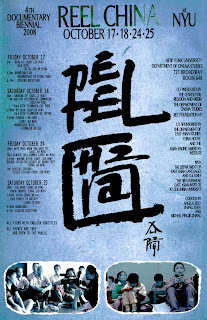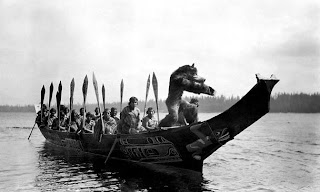
This is the schedule of events:
Friday, October 17:
1:00 pm - Opening Program. Welcome by Faye Ginsburg and Angela Zito
1:15 pm - Introduction by Zhang Zhen. "Bing Ai", by Feng Yan. 2007. 114 minutes. English subtitles. With the completion of the Three Gorges Dam, 1.13 million people along the Yangtze River will have been dislocated. The majority of them are farmers. BING AI features one woman farmer who refuses to move away from her village. The film follows her seven-year struggle with officials who pressure her to relocate, while a strong devotion to her land compels her to remain in the place she calls home.
3:30 - 4:00 pm - Q & A with scholar and critic CUI Weiping.
4:00 – 6:00 pm - Roundtable on Documentary in China Today with Jonathan Kahana (Cinema Studies), LU Xinyu (Fudan University, Shanghai), Angela Zito (CRM). Moderated by Zhang Zhen (Cinema Studies), joined by several visiting filmmakers.
6:00 pm - Opening Reception.
Saturday, October 18:
10:00 am - Introduction by Angela Zito. "Growing Up (Chengzhang)", by Li Youjie. 2007. 11 minutes. English subtitles. This witty short allows elementary, middle and high school students to share their dreams with the camera. The director describes the “hatching” process of schooling thus: “When I was small, I watched chicks hatching, excited to see tiny lives, to see them grow up slowly, mature and come into themselves. When did I myself hatch? Or, I might ask, how will I hatch someday?”
"We Are the Children of Communism (Women shi gongchan zhuyi shengluehao)", by Cui Zi’en. 2007. 94 minutes. English subtitles. The Yuanhai Migrants Children’s School closes for unknown reasons. The students manage to continue class first in a ruined factory and in the street. Then, even these makeshift classrooms disappear. In one semester, attendance drops from 720 to 16 as they learn in a minibus and in a teacher’s tiny home. Intimately shot, the film reflects the pressures that new city migrants face, and illuminates the children’s struggle.
Noon - 12:30 pm - Q & A with filmmaker Cui Zi’en.
12:30 - 1:30 pm - Break for lunch.
1:30 pm - "My Dear (Qin ai de)", by Gu Yaping. 2007. 82 minutes. English subtitles. The film records its maker’s search for herself through her relationships with several other similar urban women artists--their struggles in and out of marriage, their confusion in the face of conflicts between their ideals and realities, as well as their tense friendships which go through moments of mutual caring, understanding and discord.
3:00 - 3:30 pm - Q & A with filmmaker Gu Yaping.
3:30 - 3:45 pm - Break.
3:45 pm - "Though I Am Gone (Wo sui si qu)", by Hu Jie. 2007. 68 minutes. English subtitles. In August 1966, the Red Guards’ violent phase of 'The Great Proletarian Cultural Revolution’ spread from the educational sector to all other social circles. Within this month of ‘Red August’, Beijing alone saw 1,774 people killed. Bian Zhongyun, Vice Principal of the prestigious Beijing Normal University Girls Secondary School, was the first victim beaten to death during this month of terror. The film draws upon photographs of Bian's death taken by her husband, Wang Jingyao, eyewitness accounts from courageous interviewees and broadcast footage from the period.
5:00 - 6:00 pm - Roundtable with filmmaker Hu Jie, joined by Zhu Rikun (curator and critic) and Rebecca Karl (EAS/History).
Friday, October 24:
10:00 am - Introduction by Angela Zito. "Have Meal When You Have To (Gai chifan, chifan)", by Gao Yanfei & Wu Yifei. 2007. 69 minutes. English subtitles. In Lianzhuang, a community in the southern city of Hangzhou, there are two distinct groups of people: students who come from all over the country to take prep classes in art for the art-major of the National College Entrance Examination and those who service them. This other group includes elderly people who equally come from all kinds of regions and backgrounds and who work as models for the students.
11:15 am - "That Winter, This Summer (Nanian dongitan, jinnian xiatian)", by Yang Huazhou. 2007. 88 minutes. English subtitles. Wang Anjiang—an ethnic Miao peasant—beggared himself and his family collecting ancient Miao folksongs. During that 34-year period, his wife died because they had no money for her treatment, and his eldest son poisoned himself to death because they could not afford his tuition. Everyone blames Wang but he persists, finally managing to collect twelve volumes of folk songs ranging from “Nüwa mending the fallen sky” to those about everyday lives of the Miao people. He wants to publish these collections. After a heavy snow, the old man becomes sick. Three years later, his younger son has a family of his own and drinks less, his grandson can now walk, and Wang is even older and quieter. But he keeps repeating: “I must think of a way to publish the book…” In the end, father and son carry the folk song collection to a prospective publishing company in the city.
1:45 pm - "Wuding River (Wu Ding He)", by Li Xiaofeng & Jia Kai. 2007. 103 minutes. English subtitles. In northern Shann'xi province, the poorest region in China, many tricycle drivers left their farmland to make a living in the small city. They pin all hopes on their kids, believing their lives will change when the kids enter university. In one family, four years pass and the eldest child finally graduates, only to find there's no job waiting for her. But the family has already begun another round of battle for college competition. Instinctively, like hens, the whole family turns energy toward hatching another new hope: the younger child.
3:30 pm - "Golden Lotus—The Legacy of Bound Feet (Zhong Guo Jin Lian)", by Joanne Cheng. 2006. 59 minutes. English subtitles. The filmmaker searches the banks of the northern Yellow River and in remote villages in southwest Yunnan for the last women with bound feet, China's thousand year-old tradition of erotic beauty, mutilation and female survival. Told through the first-person narrative of the filmmaker, who was raised by her bound-foot grandmother, the film captures otherwise lost voices and the haunting memories of twelve bound-feet Chinese women aged 78 to 106, including that of the 90 year-old paper cut folk artist, Yang Huixiu. Their combination of strength and delicacy raises questions about the status of women in societies once, and still, dominated by men.
7:00 pm - Special Feature. Introduction by Zhang Zhen. "Taishi Village (Taishi Cun)", by Ai Xaoming. 2005. 120 minutes. English subtitles. Shot over twenty days in the autumn of 2005, AI Xiaoming’s film follows the escalating violence surrounding a political dispute over an election in a village in Guangzhou. Disgusted at the corruption shown by local officials in one land theft after another, the population and its government finally deadlocked over the contested recall—and we are left wondering just who are the people threatening, and in some cases literally attacking, the village organizers and their lawyers.
Saturday, October 25:
10:00 am - Introduction by Zhang Zhen. "The Road (Lu)", by Jia Ding. 2006. 56 minutes. English Subtitles. Hou-yin-dou Village is located in Mizhi County, Shaanxi Province in the middle of the Loess Plateau of central China. A new road is desperately needed to improve the living and economic conditions of the villagers. Ms. Ji Qiaoling, a poverty alleviation official sent from the county government, starts fund-raising. She tries everything: pooling funds from local villagers, applying for support at the unresponsive county bureau of transportation, and finally turning to ask a local “big bill” (da kuan)—an illiterate rich mine-owner originally from the village. The rich guy does not give a clear answer. Ji Qiaoling and her fellow officials decide to host a theatrical performance in the village and invite the mine-owner back to his hometown. The performance starts, the rich guy is back, the banquet is on, and Ji is already slightly drunk, yet the “big bill” still holds back his promise…
11:00 am - "Torch Troupes (Huo Ba Ju Tuan)", by Xu Xin. 2006. 110 minutes. English subtitles. “Torch Troupes” got their name during the Cultural Revolution, when traditional Sichuan Opera was prohibited in public and troupes could only tour remote rural areas, performing underground at night by torchlight. In 2001, six national Sichuan Opera companies were integrated into one that rarely performs. Today, the informal show troupes created by Sichuan Opera actors dismissed by national companies in the 1990s have become the new struggling “torch troupes.” Three or four of them continue to perform in tea-houses scattered in the old neighborhoods of Chengdu. With the ageing audience and teahouse venues disappearing, some actors switch to “dance shows” or turn to running small businesses. Li Baoting, a master of Sichuan opera, began his career at eight but now mingles with showgirls in popular and cheap bars. On the other hand, actor Wang Bin refuses to give up, going on with his troupe in a temporary tent in this big city where everybody seems to be in a rush.
1:45 pm - Introduction by Richard Allen and Angela Zito. "Faith (Xin Xin)", by Wei Xueqi. 2008. 98 minutes. English subtitles. Director Bai is the person-in-charge of the local church. There are five services in Yiminhe but only one is legal. Every day, Director Bai has to rush to different services, so she wants to build a big church to hold them all. After two years of effort, approval is secured. The documentary begins as construction commences, with insufficient funds raised by local Christians. Eventually costing over one million RMB, the construction has trapped Director Bai in a web of huge debt. The contractor refuses to hand over the church, Bai continues to fund-raise, and the Christians still use their original venues.
3:30 pm - "Idle People in Society (Xianzhe)", by Zhang Weijie. 2006. 79 minutes. English subtitles. This documentary presents the life of four street performing singers from various walks of life: Old Fang, an unemployed worker; Old Zhao, an unemployed migrant peasant worker; Shi Jing, a widow from Shandong Province; and Little Ding, another unemployed man who tries to support his child in college. They work hard, but without acknowledgement from family members and society. Amidst challenges and setbacks, they use singing in the streets to seek dignity, explain history and reality, vent their happiness and sadness, and pray for a better tomorrow.
4:50 - 5:50 pm - Roundtable with Hao Jian (scholar and critic), Cui Weiping (Scholar and critic), and Xudong Zhang (EAS). Moderated by Angela Zito.
6:00 - 7:00 pm - Closing reception.
 In the 1940's, curator and founding director Hilla Rebay planned to establish a film center at the Museum of Non-Objective Painting, which later became the Solomon R. Guggenheim Museum, to collect and promote nonobjective films. She awarded grants to artists and presented programs of short experimental films. With the help of Oskar Fischinger, an elaborate film center was planned to include studios and planetarium-style projection capability. Although unrealized, Rebay's support enabled many filmmakers to continue their work in abstract film. This program presents short films by filmmakers whose work was screened and/or supported by Rebay, including Jordan Belson, Mary Ellen Bute, Charles Dockum, Oskar Fischinger, Norman McLaren, Hans Richter, Harry Smith, among others. Having experimented with nonobjectivity, many of these artists were familiar with the work of Vasily Kandinsky, one of its most famous practitioners.
In the 1940's, curator and founding director Hilla Rebay planned to establish a film center at the Museum of Non-Objective Painting, which later became the Solomon R. Guggenheim Museum, to collect and promote nonobjective films. She awarded grants to artists and presented programs of short experimental films. With the help of Oskar Fischinger, an elaborate film center was planned to include studios and planetarium-style projection capability. Although unrealized, Rebay's support enabled many filmmakers to continue their work in abstract film. This program presents short films by filmmakers whose work was screened and/or supported by Rebay, including Jordan Belson, Mary Ellen Bute, Charles Dockum, Oskar Fischinger, Norman McLaren, Hans Richter, Harry Smith, among others. Having experimented with nonobjectivity, many of these artists were familiar with the work of Vasily Kandinsky, one of its most famous practitioners.







